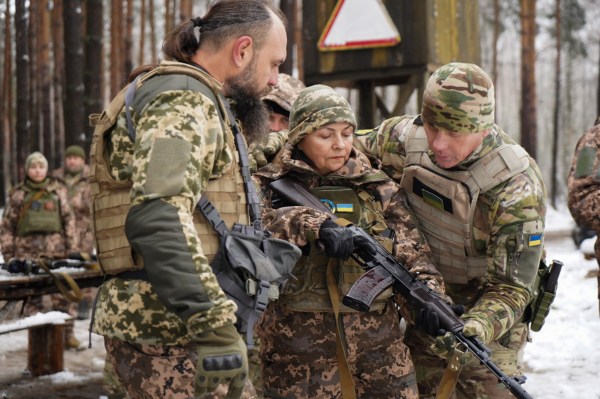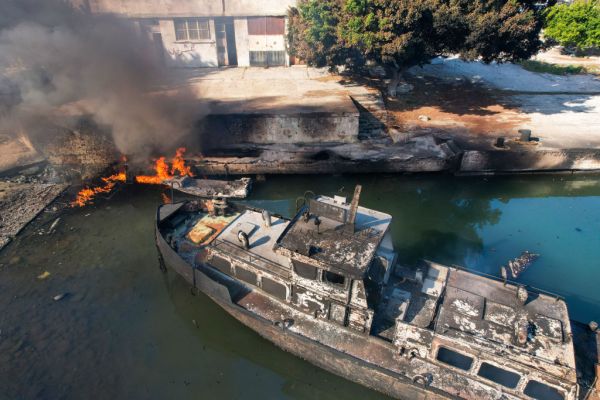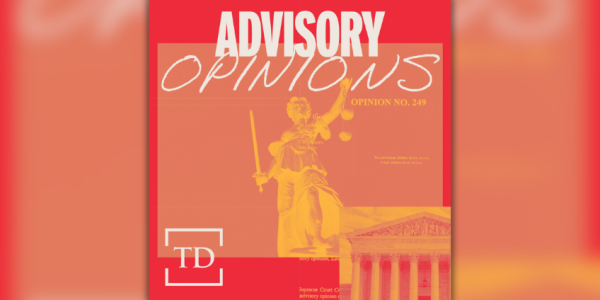Happy Tuesday! If you manage not to laugh out loud at this tennis announcer’s reaction to “Cotton-Eyed Joe” unexpectedly disrupting a rally during the Canadian Open this weekend, we will pay you $100 (out of Jonah’s salary).
Quick Hits: Today’s Top Stories
- A grand jury in Fulton County, Georgia indicted former President Donald Trump and 18 of his political allies late last night, charging the group—which includes onetime Trump lawyers Rudy Giuliani, Sidney Powell, and Jenna Ellis as well as his former chief of staff, Mark Meadows—with violating the state’s racketeering (RICO) law for their alleged efforts to “unlawfully change the outcome of the [state’s 2020] election in favor of Trump.” Trump was also hit with several other counts, including solicitation of violation of oath by public officer, conspiracy to commit forgery, filing false documents, and more. Fulton County District Attorney Fani Willis spoke briefly to reporters early this morning, announcing Trump and his 18 co-defendants have until noon on August 25, 2023 to turn themselves in to officials in Georgia.
- Hunter Biden’s lawyers filed a motion late Sunday night arguing that part of the now-defunct plea deal with federal prosecutors—the provision resolving a felony gun charge for lying about drug use on firearm purchase form—is still “valid and binding.” The judge overseeing the case told prosecutors they had until noon on Tuesday to respond. Citing “prosecutors’ contemporaneous written and oral communications” as corroboration, the filing from Hunter’s legal team also claimed that U.S. Attorney David Weiss and his team understood the scope of the immunity afforded to Hunter by the plea deal before it collapsed, and have since “renege[d] on the previously agreed-upon plea agreement.”
- Two Russian bombers flew near NATO airspace over the North Sea on Monday, prompting Denmark and the Netherlands to deploy F-16 fighter jets in response. The Russian planes then turned back, never having left international airspace. According to North American Aerospace Defense Command (NORAD), four Russian aircraft also flew into Alaska’s air defense identification zone late Sunday and early Monday, but similarly remained in international airspace. “This Russian activity in the Alaska ADIZ occurs regularly and is not seen as a threat,” NORAD said in a statement.
- The Pentagon announced a new $200 million security assistance package for Ukraine on Monday, tapping into previously approved congressional aid to send Ukraine additional munitions for HIMARS and Patriot air defense systems, as well as artillery rounds, tactical vehicles, Javelins, and mine clearing equipment. The drawdown was funded by the additional $6.2 billion made available after a Pentagon accounting error; President Joe Biden asked Congress last week for an additional $24 billion to support the Ukrainian war effort. Ukrainian forces have reportedly gained ground in the southeast in recent days, retaking at least part of Urozhaine and pressuring Russian forces in the neighboring village of Staromaiorske.
- The military junta that seized power in Niger last month announced plans over the weekend to charge the deposed president, Mohamed Bazoum, with high treason. Bazoum and his family have been detained since the coup, and, if convicted of the charge, could face the death penalty.
- Pakistan’s two major political parties agreed Saturday to appoint a caretaker prime minister—Anwar-ul-Haq Kakar—to oversee the country’s general elections after the country’s National Assembly was dissolved last week. Kakar—a senator from the western province of Balochistan who has the backing of Pakistan’s military—will serve as premier until elections, which were due to be held in November but may be delayed to incorporate the results of a new census.
- The Education Department and Justice Department released new guidance to colleges and universities on Monday outlining how to navigate race considerations in admissions—including how to assess admissions essays that highlight applicants’ race—following the Supreme Court’s June decision gutting affirmative action. According to the document, “a university could consider an applicant’s explanation about what it means to him to be the first Black violinist in his city’s youth orchestra or an applicant’s account of overcoming prejudice when she transferred to a rural high school where she was the only student of South Asian descent.”
Trump & Friends Indicted in Georgia

Just after midnight this morning—exhibiting little to no regard for the sleep schedule of morning newsletter writers—Fulton County District Attorney Fani Willis walked out behind a podium to detail the sprawling indictment that had finally been unsealed about an hour earlier. “Based on information developed by [our] investigation, a Fulton County grand jury returned a true bill of indictment charging 19 individuals with violations of Georgia law arising from a criminal conspiracy to overturn the results of the 2020 presidential election in this state,” she said. After a few more minutes of details, she concluded: “I will now take a very limited number of questions prior to going to sleep.”
The activity of Willis and her team in recent months had more or less made clear such a move was coming, but the scope of the indictment—19 defendants!—still managed to shock even the closest political observers. Former President Donald Trump was hit with numerous charges, of course, but so were several of his lawyers during the post-election period (Rudy Giuliani, John Eastman, Sidney Powell, and Jenna Ellis), his former chief of staff (Mark Meadows), a onetime Trump campaign aide (Mike Roman), and the Georgia GOP Chairman David Shafer. The grand jury voted yesterday to bring a total of 41 felony counts, and 13 of those are against Trump himself, who has now been indicted four separate times in as many months.
Longtime Dispatch members know that we prefer to avoid the kind of insta-reactions that often leave out significant details or fail to convey important nuances—just to meet an artificial deadline. (As we said in our very first post: “We will be timely and topical, but we won’t be slaves to the relentless pace of the news cycle. We will slow things down, deliberately—because we think the times require more deliberation. Whenever possible, we want to pause and think before we react, to research and report before sharing our views.”) So we’ll take a beat, do lots of reporting, and we’ll meet you back here in 24 hours with a much better sense of the indictment’s substance and the political and legal dynamics at play.
In the meantime, here’s a 30,000-foot view from our resident legal expert, Sarah Isgur: “The biggest difference with this indictment is how much broader Georgia’s laws are compared to federal RICO laws—and certainly compared to the federal indictments we’ve already seen. The facts may overlap, but the laws are quite different. We’re also looking at a lot more people involved—from Mark Meadows to Jenna Ellis. It will be interesting to see whether any of these co-defendants end up testifying.”
And Now For Your Regularly Scheduled Programming
Former President Donald Trump simply cannot stop posting on social media—and it could very well lead to real legal consequences.
Trump is now facing prosecution in four separate jurisdictions, and the judges overseeing these cases are scrambling to figure out how to deal with a defendant known for his provocative comments and Mafia-style threats—who also happens to be running for president. After a flurry of legal filings over the last couple of weeks, one Trump social media posting in particular may have led to a limited protective order in one of special counsel Jack Smith’s cases. While the decision of whether to bring additional charges of witness tampering or obstruction of justice against Trump ultimately lies with prosecutors, at least two judges have already warned Trump his online rhetoric is over the line.
At the beginning of the month, a federal grand jury handed down a four-count indictment against Trump—his second set of federal charges—resulting from Smith’s investigation into the former president’s alleged effort to overturn the 2020 election. On August 3, Trump was arraigned in Washington, D.C., where the magistrate judge overseeing the hearing—during which he pleaded not guilty—issued a warning to the defendant. “I want to remind you it is a crime to intimidate a witness or retaliate against anyone for providing information about your case to the prosecution, or otherwise obstruct justice,” Magistrate Judge Moxila A. Upadhyaya told Trump. “Do you understand these warnings, sir?” He nodded “yes.”
He may not have taken the advice to heart, though. The following day, the former president posted an ominous “truth” on his social media platform, Truth Social: “IF YOU GO AFTER ME, I’M COMING AFTER YOU.” A spokesperson for Trump said Saturday the statement was in response to “the RINO, China-loving, dishonest special interest groups and Super PACs.”
Following the “truth,” Smith and his team asked that the evidence in discovery be under a protective order. Translated from legalese, Smith & Co. wanted to limit what Trump and his team can say publicly about evidence they became aware of during the discovery process.
The government requested that all communication about any of the evidence in discovery be limited to Trump, his legal team, and a small number of additional people related to the defense—like witnesses for the defense and their lawyers. They also sought to designate certain evidence as “sensitive,” which Trump could view only in the presence of defense counsel. The sum of the evidence can include anything from subpoenaed documents to videos of witness testimony—this particular case has amassed more than 11 million documents and files. “The purpose of the protective order is primarily to protect the integrity of the judicial proceedings,” a former United States attorney tells TMD, requesting anonymity to speak candidly about Trump’s travails. “And in this case, we are looking to protect those documents and the individuals identified in them from any collateral consequences of being outed publicly.”
While prosecutors underlined in their motion that what they were asking for was standard procedure—a judge issued a protective order in June over evidence in Smith’s case about Trump’s handling of classified documents—they also suggested it was even more crucial than usual, given Trump’s social media activity and propensity to target his opponents online. “If the defendant were to begin issuing public posts using details—or, for example, grand jury transcripts—obtained in discovery here, it could have a harmful chilling effect on witnesses or adversely affect the fair administration of justice in this case,” prosecutors wrote in the filing, which included Trump’s August 4 post. Among the people to testify before the grand jury, for example, is Mike Pence—Trump’s former vice president and current 2024 rival. Think Trump might be interested in bringing up anything Pence said to prosecutors in a future debate?
The former president’s lawyers fired back last week with a legal filing of their own, arguing that muzzling Trump and his team’s potential comments about evidence in the case amounts to stifling their First Amendment right to free speech—particularly during an election season—and elevating the court to “the role of censor.”
Trump’s attorney, John Lauro, did the rounds on the Sunday morning shows after Smith’s filing, making that same argument, adding that—since Trump was a political candidate—the people had a right to know what evidence there was against him. The government’s filing in rebuttal accused the defense of desiring to try the case in the “court of public opinion.”
When the two parties—without Trump present—presented themselves at a hearing on Friday, the federal judge overseeing the trial, Tanya Chutkan, wasn’t buying many of the former president’s arguments. “The existence of a political campaign is not going to have any bearing on my decision,” Chutkan said. “I’m going to keep politics out of this.” She issued a protective order—not one as expansive as prosecutors pushed for, nor as loose as Trump’s team preferred—limiting how much Trump can say publicly about “sensitive” evidence, which she indicated included witness interviews and recordings. Chutkan, even in awarding a slight victory to the Trump team, also issued a stern warning that even “arguably ambiguous statements” could be interpreted as witness intimidation—seemingly a pointed reference to his August 4 tweet.
At least as far as criminal proceedings go, the judges cautions to Trump were normal, “especially in cases where there may appear to be proclivity from a defendant to [engage in witness tampering or obstruction],” the former federal prosecutor tells TMD. Even in being fairly standard, it’s also legally superfluous, since witness tampering and obstruction are already against the law.
Trump hasn’t been so ambiguous in his attacks against other players in his various indictments. After Upadhyaya’s warning, he called Pence—likely to play a key role in Smith’s prosecution—“delusional,” and labeled Smith “deranged.” Since Chutkan’s warning, he’s referred to Fulton County District Attorney Fani Willis by the moniker “Phoney Fani,” and argued that former Georgia Lt. Gov. Geoff Duncan shouldn’t testify before Willis’ grand jury because he’s a “nasty disaster.” Yesterday, he even said Chutkan herself “obviously wants me behind bars” based on statements she made while presiding over January 6 prosecutions.
When does all his needling become too much? Whenever prosecutors decide they have evidence of obstruction or witness tampering beyond a reasonable doubt—and feel like bringing those charges would help their case. But, the warnings from the judge aren’t nothing, the former U.S. attorney says. “I think it’s almost like a warning shot, putting the former president’s team on notice that the court intends to protect the integrity of the judicial proceedings and the witnesses that come before it.”
Record-Breaking Wildfires Ravage Maui
Around 4:00 a.m. last Tuesday, Haumea Lucas was awoken by strong winds outside her family’s home in Lahaina, Hawaii, that led to a sudden power outage. Later that morning, she reported to work at Island Grocery Depot; raised in Maui, Lucas is used to the strong storms that often hit the islands during hurricane season.
That afternoon, however, Lucas and her coworkers looked up to see black smoke billowing across the sky. With no cell service and no warning sirens to be heard, she assumed a downed power line had caught on fire. After leaving the store in a car packed with groceries, though, they quickly realized a dangerous blaze was rapidly consuming Lahaina, the onetime capital of the Kingdom of Hawaii.
“We didn’t get anything,” Lucas, 23, tells TMD. “All the information that we had was from social media. So my coworkers were getting information from Facebook or their families who were at their houses and trying to get out.”
After arriving at her coworkers’ grandparents home a safe distance from the fire, Lucas received word from her family: their home was gone. They had attempted to throw water on the house to prevent it from catching fire, but once the house next door caught ablaze, they were forced to flee.
Since Tuesday, the confirmed death toll in Maui has risen to 99, making it both the deadliest American wildfire in over a century and the deadliest natural disaster in Hawaiian history. That figure is also almost assuredly an undercount. Four fires in Maui have combined to burn nearly 3,000 acres over the past week, destroying thousands of buildings in the process. As of the county’s Monday morning update, one fire is fully extinguished, one is 100 percent contained (meaning firefighters have it fully surrounded by a perimeter), and the other two—in Kula and Lahaina—are 60 percent and 85 percent contained, respectively.
Hawaii Gov. Josh Green said last week that more than 1,000 people remained unaccounted for, signaling that the death toll from the tragedy would likely continue to rise. He later told CBS News that crews could find 10 to 20 people per day, with a final count not expected for about a week and a half. Officials just recently began searching affected areas with canine teams, having only confirmed the identities of two victims and searched about 3 percent of Lahaina as of Saturday.
“The closest thing I can compare it to is perhaps a war zone, or maybe a bomb went off,” Maui County Mayor Richard Bissen told ABC on Friday. “It was cars in the street, doors open, you know, melted to the ground. Most structures no longer exist.”
While the origin of the Lahaina fire is unknown, a number of factors came together to create the perfect conditions for a ferocious and fast-moving blaze. Lahaina is one of the driest areas of Maui to begin with, and it’s only grown drier and hotter in recent years. Add highly flammable invasive species—which have run rampant since being introduced to the island as forage for livestock—and Hawaii becomes prime ground for wildfires to spread.
Curtis Daehler, a professor of botany at the University of Hawaii, says that while Maui has undergone extended periods of drought in recent years, a particularly wet spring allowed for non-native grasses to build up biomass, setting the stage for the fires. “The grasses often promote themselves after the fires, and they do it very quickly because they either re-sprout or they come up from seeds, and then that in turn within the next season can form new, flammable biomass, and again, cause another fire,” he tells TMD. “So this happens over and over again, and basically, any other vegetation that was in there that might have been less flammable eventually disappears because of the constant fires that are promoted by these grasses.”
As the fires ignited in Maui last week, Hurricane Dora was also raging about 450 miles off the island’s coast. While the storm never touched Hawaii, it contributed to gusts of up to 60 miles per hour that picked up speed and heat as they passed over Maui’s mountains, providing the fuel for the fires to travel one mile per minute—faster than word could spread. The blaze advanced so quickly, in fact, that more than a dozen people ended up running directly into the Pacific Ocean to escape the flames. Daehler says the roads and residential development of Lahaina provided “fire breaks” that would usually prevent a wildfire from spreading quickly, but that the high winds led to unpredictably fast expansion.
Maui has 80 siren towers meant to alert residents of disasters just like this one, but according to the Associated Press, the emergency warning system never went into effect. Officials instead sent alerts to cell phones, televisions, and radio stations, leaving the thousands of residents without power or cell service out of luck.
With no more than 65 firefighters on duty at any given time, Maui’s first responders struggled to contain the fires, encountering empty or unusable fire hydrants and lacking the tools needed to fight brush fires. Hawaii Attorney General Anne Lopez announced Friday that her department would launch “a comprehensive review of critical decision-making and standing policies leading up to, during, and after the wildfires on Maui and Hawaiʻi islands this week.”
Lisa Benton-Short, a professor of geography at George Washington University, notes climate change is forcing local officials to prepare for a wider array of environmental disasters than ever before. Hawaii, for example, has the infrastructure to communicate with and protect residents from severe storms, but it lacks the same preparation for wildfires. According to Benton-Short, officials must prioritize vulnerable populations—like elderly people without easy access to the internet or communities in low-lying or dry areas—to mitigate the death toll of future disasters.
The island’s top priorities right now are of course fully containing the fires, recovering and identifying victims, and finding housing for thousands of displaced residents. But the island’s long-term recovery will require extensive resources, with Green estimating the fires to have caused nearly $6 billion in damages. “If you look at what’s been seen now in West Maui, 2,200 structures have been destroyed or damaged,” he said. “Eighty-six percent are residential.”
President Joe Biden declared a major disaster, allowing federal funds to be used in supporting recovery efforts. According to the White House, more than 300 FEMA personnel have been deployed to Hawaii, and FEMA Administrator Deanne Criswell said a one-stop disaster recovery center will be stood up in “the coming days.” The Coast Guard is working to assess structural damage in Lahaina harbor, and the U.S. Army Corps of Engineers has been called in to help clear roads and restore electrical service.
But even as streets are cleared, power is restored, and buildings are rebuilt, the survivors of the wildfires will never forget the terror they experienced over the past week. “My mind kept going back to: This has got to be just a nightmare. This cannot be real. This cannot actually be happening,” said Mike Cicchino, who along with his wife was forced to jump over the seawall separating the town from the ocean to escape the flames. “But then you realize you’re burning. I’m feeling pain, and I don’t feel pain in nightmares.”
Worth Your Time
- In a piece for Politico, Jonathan Martin profiles Mitch McConnell, diving into the Senate minority leader’s push to steer his party away from Donald Trump’s isolationist foreign policy. “Of all the ways Trump has reshaped the Republican Party, it’s clear that McConnell sees the drift toward isolationism as the most pernicious—particularly at a moment when the fate of Ukraine and perhaps even NATO countries could be determined by the resolve of the Republican Party,” Martin writes. “The party’s drift on foreign policy wouldn’t have been reversed, but Trump would not have the same authority on this, or any, issue had McConnell sought 10 more Senate Republicans to convict the former president of his second impeachment and barred him from seeking office again. He said at the time that he was convinced by constitutional arguments about impeaching a president no longer in office, but clearly his caucus’s lack of appetite for conviction weighed on him.”
Presented Without Comment
Washington Free Beacon: Vacationing Biden Blows Off Question About Rising Hawaii Death Toll: ‘No Comment’
Also Presented Without Comment
CBS News: 3 Military Branches Without Senate-Confirmed Leaders for First Time in History, Defense Secretary Says
Also Also Presented Without Comment
San Francisco Chronicle: Crime is So Bad Near S.F. Federal Building Employees Are Told to Work From Home, Officials Said
Toeing the Company Line
- In the newsletters: Audrey explains why Iowa is still an important litmus test for GOP presidential hopefuls, Kevin explores (🔒) the parallels between inherited wealth and inherited intelligence in society, and Nick comes to (🔒) Jonah’s defense on the detrimental effect of small political donors.
- On the podcasts: Ari Cohn joins Sarah and David on Advisory Opinions to discuss the legal complexity of age-restriction policies.
- On the site: Richard Goldberg lays out his issues with the Biden administration’s Iran prisoner deal, Stirewalt highlights voters’ role in restoring public virtue, and Walter Olson writes about what a bipartisan attack on the legitimacy of the Supreme Court would look like.
Let Us Know
Have you ever experienced a fast-moving fire? Or seen the aftermath of a destructive wildfire? What was it like?










Please note that we at The Dispatch hold ourselves, our work, and our commenters to a higher standard than other places on the internet. We welcome comments that foster genuine debate or discussion—including comments critical of us or our work—but responses that include ad hominem attacks on fellow Dispatch members or are intended to stoke fear and anger may be moderated.
You are currently using a limited time guest pass and do not have access to commenting. Consider subscribing to join the conversation.
With your membership, you only have the ability to comment on The Morning Dispatch articles. Consider upgrading to join the conversation everywhere.